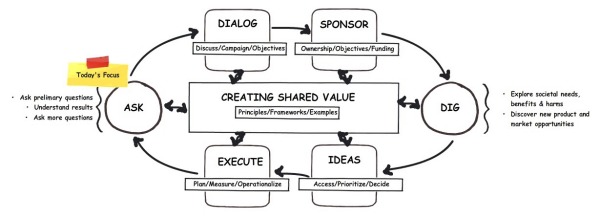Let’s assume you are as excited as I am about Pairing Passion with Purpose by Creating Shared Value. You recognize that not all profit is equal and that you can enhance your profitability while simultaneously advancing the social and economic conditions of your community. You want to rethink your purpose and leverage the proven concepts pioneered by smart companies such as Google, Nestle, J&J, Molson Coors Brewing, IBM, GE, and Wal-Mart.
So how do you get started? If we zoom out to the birds-eye view, this diagram illustrates our roadmap at a very high level. Within each step are numerous powerful methods and frameworks to support your journey and effectively enable your Shared Value strategies.

Today, we will zoom in and take a worms-eye view to ‘ASK’ the key preliminary questions essential to shaping a Shared Value strategy:
- What is your level of influence within your organization?
- What is the size of your organization (# of employees)?
- What is the level of maturity of your organization?
- Do you have the right resources to initiate Shared Value strategies?
- Is your organization open to meaningful change?
How you answer these five questions will determine your potentiality for positive change and shape the best way for you to get started on this journey. We will examine each question and derive a recommended course of action. Rethinking your corporate purpose is not a prescriptive process; each organization is unique and will have its own nuances that need to be taken into account..
What is your level of influence within your organization?.
Executive leadership:
If you are at the executive decision-making level then forge ahead and proceed to the next question.
Middle management:
You may not have the authority to initiate a corporate level initiative like this but, hopefully, you have direct access to senior or executive leaders that do. Begin with a dialog, ask probing questions that explore the principles of creating Shared Value and share the Nestle example to initiate an awareness campaign.
The beauty of the Shared Value movement is that it can be scaled right down to the team level. If you have autonomy over your own team, then begin to educate your own team. Be open with them about what you are doing and make them a part of the solution. Demonstrating these principles within your team will provide you with concrete results to draw from on your broader campaign with your peers and organizational leadership team.
Associate and other:
If you do not have decision making authority and have not previously been a front line change agent, now is the time for you to start. Start the dialog with your peers and managers. Ask probing questions that explore your organization’s purpose and its potential to simultaneously enhance profits by addressing social issues within your customer community. Be sure to leverage any channels that your organization has established for communication and idea generation..
What is the size of your organization (# of employees)?.
Small (1-50 employees):
If you work for a small organization, simply be audacious and proceed to the next question.
Medium (50-500 employees):
If you work for a medium sized company, consider taking a blended approach. For broader Shared Value strategies that easily enable your company strengths, seek corporate level sponsorship. For strategies that are narrower in focus, target a progressive division or business unit. Then you can leverage your demonstrated success to attain corporate sponsorship to scale your efforts. This incremental approach also breeds change more organically.
Large (500-5000+ employees):
Many large organizations have a Corporate Social Responsibility (CSR) practice. If your company has one, this means that your company is already doing good things; they should celebrate doing them with an economic benefit for all. If your company does not have a CSR practice, set your initial focus on a division or business unit. Some behavioral changes beyond your initial focus may be adopted quickly, be sure to embrace them and celebrate them when they occur. Being part of a large organization is not a reason to accept defeat, large companies often have more resources available to assist you in soliciting like-minded support and sponsorship. Leverage your companies’ social media tools and communication channels to start the dialog..
What is the level of maturity of your organization?.
Start up (Years 1-5):
The paradox with a start up organization is that it is much easier to develop a Shared Value corporate culture from the beginning than to change it later, yet few have the foresight to seize this unique opportunity. In an ideal world, we would get it right from the start. However, the reality is that this is often when you have the least amount of resources and capital available coupled with pressures and goals narrowly focused on short term payoffs. Resist the temptation to postpone developing your Shared Value strategies until “there is more time” or “more resources and capital”. Your start up is a marathon, not a sprint. A Shared Value strategy will profoundly impact your potentiality to move forward.
Growth (Years 5-10):
If you are at a growth stage, your company is likely open to exploring innovative ways to create sustainable profits. Lead with this as a motivator.
Mature (Years 10+):
Granted, it can be challenging to “teach an old dog new tricks” but, chances are that if this is the case for your organization, you are on a narrow path to extinction. A healthy Shared Value approach is essential for the longevity of mature companies. As we navigate through and beyond the age of hyper transparency, mature companies will need to embrace meaningful change to survive. You will need to be audacious and tenacious to ignite and enlighten a mature team..
Is your organization open to meaningful change?.
Change resistant:
This is more common than you might think. While fear driven leaders are a dying breed, they broadly represent the majority of business leaders today. Typically, these leaders are egocentric and resistant to meaningful change if it does not have an immediate positive impact to the bottom line. This is the only scenario that I recommend a rather unconventional approach. Try your best to enlighten your leadership team to broaden their mindset by appealing to their desire to maximize profits. If it resonates, celebrate and move forward. If you are met with strong resistance, then you need to make a personal decision. Do you want to work for a company that refuses to consider meaningful change? While followers excel in this type of environment, change agents typically do not thrive under these conditions.
Adaptive:
Unquestionably the lesser of two evils, you will still need to ignite your company and then diligently keep it ignited. Keep the dialog at the forefront and leverage all social media tools and communications channels available to you. Ensure collective ownership by inviting everyone to become part of the solution.
Change opportunists:
If you are at a company that has a proven track record for embracing meaningful change then you are half way there, leverage this to the fullest..
Do you have the right resources to initiate Shared Value strategies?.
Ideal mix:
Do not underestimate the importance of having a blended team. An ideal mix would include a sponsor, an evangelist, an external advisor, and a driver. Insufficient resources will impede your ability to attain and sustain the momentum needed. With an external advisor, you will minimize distractions and maximize your potential to leverage proven practices. The right external advisor will also be far less subject to political influences and will empower you with the kind truth – something you may not want to, but need to hear.
Part of the engine:
If you have a piece of the equation; either some of the skills, the capital to acquire new skills, or a trusted advisor, then begin with a narrow initiative that has highly measurable rewards. Select a progressive team, division or business unit to demonstrate the returns that would ultimately provide tangible justification for further investment and sponsorship.
Lack of skills and capital to acquire new skills:
This is one of the top challenges. In this scenario, you will initially need to rely heavily on your own passion and audaciousness to become both an expert and an evangelist (or solicit the help of an expert and explore creative ways to augment upfront costs by enabling them to benefit economically from successful outcomes of Shared Value strategies). If you are lacking in capital, perhaps a Shared Value approach is what you need to enhance your profitability.
.
The goal of today’s article is to put your Shared Value journey into the context of your corporate environment. If you would like to further examine and enhance your corporate environment broadly you may find this Group of Seven Insights Report helpful.
In my next article we will focus on the essential “DIALOG” needed to get your Shared Value journey in motion.






